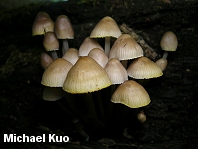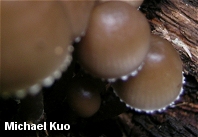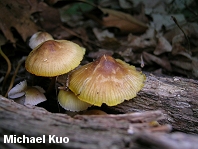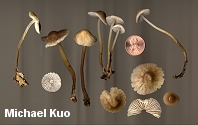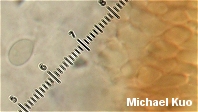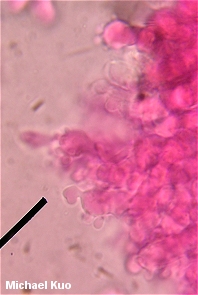| Major Groups > Gilled Mushrooms > Pale-Spored > Mycenoid Mushrooms > Mycena inclinata |

|
Mycena inclinata [ Basidiomycetes > Agaricales > Tricholomataceae > Mycena . . . ] by Michael Kuo Mycena inclinata grows in clusters on the well decayed wood of hardwoods, primarily in eastern North America, in spring or fall. It features a white spore print, a broadly conic to bell-shaped cap that features tiny "teeth" along the margin when young, a stem that is pale yellow above and brown to reddish brown below, and a strongly mealy odor. In my collections, from the Midwest, the cap color is fairly variable--but yellow stains often develop, especially near the margin, as the mushrooms mature. Truth be told, both Mycena inclinata and its close look-alike Mycena galericulata are European species whose presence in North America is debatable, and North American mycologists have tried over the years to fit their collections into European descriptions, often having to adopt a "best-fit" sort of attitude. It would not surprise me a bit if contemporary DNA studies were to conclude that we have any number of inclinata/galericulata-like species on our continent, none of which is a genetic match to the European species bearing these names. Below is a summary of features separating Mycena inclinata and Mycena galericulata, according to European and North American authors, and notes on a few other potential look-alikes. Description: Ecology: Saprobic on the well decayed wood of hardwoods; usually growing in dense clusters (but sometimes growing alone or scattered); spring and fall (or over winter in warmer climates) widely distributed east of the Rocky Mountains, and occasionally reported on the West Coast. Cap: 1-5 cm; broadly conical, becoming broadly bell-shaped and usually retaining a central bump; vaguely lined or grooved radially; bald; tacky; the margin usually featuring tiny, fringe-like "teeth" when young, and in age often becoming somewhat tattered, or splitting; color variable (brown to yellowish brown, brownish or tan, but often developing yellow stains and areas); fading to dingy whitish with exposure to sunlight. Gills: Narrowly attached to the stem; close or nearly distant; sometimes with well developed cross-gills when mature; whitish to pale grayish, sometimes becoming yellowish or pinkish in age; not bruising or staining. Stem: 5-10 cm long; 2-4 mm thick; equal; hollow; bald or with tiny fibers and flakes, especially when young; whitish near the apex, yellowish to yellow in the midsection, and brown to reddish brown below. Flesh: Insubstantial; pale. Odor and Taste: Odor mealy to foul and mealy; taste mealy. Chemical Reactions: KOH negative to brownish on cap surface. Spore Print: White. Microscopic Features: Spores 7-10 x 5-7 µ; amyloid; broadly elliptical; smooth. Pleurocystidia absent. Cheilocystidia abundant; of the "broom cell" type, with rod-like projections and nodes. Pileipellis elements diverticulate, with short nodes and rod-like projections. REFERENCES: (Fries, 1838) Quélet, 1872. (Saccardo, 1887; Smith, 1947; Moser, 1978; Breitenbach & Kränzlin, 1991; Phillips, 1991/2005; Hansen & Knudsen, 1992; Metzler & Metzler, 1992; Horn, Kay & Abel, 1993; Miller & Miller, 2006.) Herb. Kuo 06109601, 05260304, 06070304; 09300503; 05060602. According to European authors (Breitenbach & Kränzlin, 1991; Moser, 1978; Hansen & Knudsen, 1992) the features separating Mycena inclinata and Mycena galericulata can be summarized as follows: Mycena inclinata Mycena galericulata To these differences North American mycologist Alexander Smith (1947) added that in his collecting experience the lower stem of Mycena inclinata, unlike that of Mycena galericulata, was covered with a whitish coating of fibrils when young--and that as the stem grew the covering broke up into "fibrillose flecks" on the stem surface. The "flecks" banner was then taken up by North American authors (e.g. Arora, 1986; Lincoff, 1992; Miller & Miller, 2006), leading to confusion since both species usually feature at least some mycelial fuzz at the base of the stem. Mycena maculata, another European species that is often treated as North American, grows on the wood of hardwood or conifers and develops reddish stains and spots, especially on the gills and stem. Mycena pseudoinclinata, named from eastern North America by Smith (1947), differs from Mycena inclinata on a microscopic basis; its cheilocystidia are not as large, and develop only occasional finger-like outgrowths. This site contains no information about the edibility or toxicity of mushrooms. |
© MushroomExpert.Com |
|
Cite this page as: Kuo, M. (2010, December). Mycena inclinata. Retrieved from the MushroomExpert.Com Web site: http://www.mushroomexpert.com/mycena_inclinata.html |
